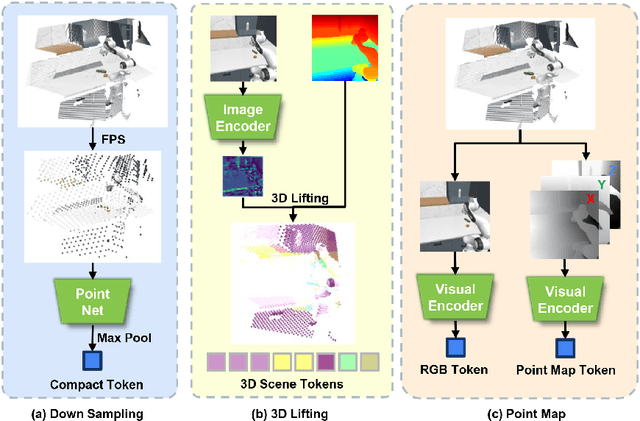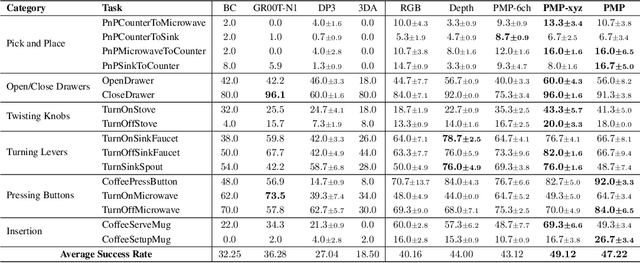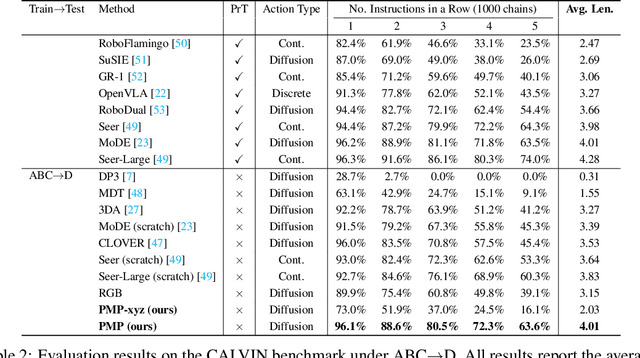Qian Wang
Henry
Subsecond 3D Mesh Generation for Robot Manipulation
Dec 30, 2025Abstract:3D meshes are a fundamental representation widely used in computer science and engineering. In robotics, they are particularly valuable because they capture objects in a form that aligns directly with how robots interact with the physical world, enabling core capabilities such as predicting stable grasps, detecting collisions, and simulating dynamics. Although automatic 3D mesh generation methods have shown promising progress in recent years, potentially offering a path toward real-time robot perception, two critical challenges remain. First, generating high-fidelity meshes is prohibitively slow for real-time use, often requiring tens of seconds per object. Second, mesh generation by itself is insufficient. In robotics, a mesh must be contextually grounded, i.e., correctly segmented from the scene and registered with the proper scale and pose. Additionally, unless these contextual grounding steps remain efficient, they simply introduce new bottlenecks. In this work, we introduce an end-to-end system that addresses these challenges, producing a high-quality, contextually grounded 3D mesh from a single RGB-D image in under one second. Our pipeline integrates open-vocabulary object segmentation, accelerated diffusion-based mesh generation, and robust point cloud registration, each optimized for both speed and accuracy. We demonstrate its effectiveness in a real-world manipulation task, showing that it enables meshes to be used as a practical, on-demand representation for robotics perception and planning.
MindWatcher: Toward Smarter Multimodal Tool-Integrated Reasoning
Dec 29, 2025Abstract:Traditional workflow-based agents exhibit limited intelligence when addressing real-world problems requiring tool invocation. Tool-integrated reasoning (TIR) agents capable of autonomous reasoning and tool invocation are rapidly emerging as a powerful approach for complex decision-making tasks involving multi-step interactions with external environments. In this work, we introduce MindWatcher, a TIR agent integrating interleaved thinking and multimodal chain-of-thought (CoT) reasoning. MindWatcher can autonomously decide whether and how to invoke diverse tools and coordinate their use, without relying on human prompts or workflows. The interleaved thinking paradigm enables the model to switch between thinking and tool calling at any intermediate stage, while its multimodal CoT capability allows manipulation of images during reasoning to yield more precise search results. We implement automated data auditing and evaluation pipelines, complemented by manually curated high-quality datasets for training, and we construct a benchmark, called MindWatcher-Evaluate Bench (MWE-Bench), to evaluate its performance. MindWatcher is equipped with a comprehensive suite of auxiliary reasoning tools, enabling it to address broad-domain multimodal problems. A large-scale, high-quality local image retrieval database, covering eight categories including cars, animals, and plants, endows model with robust object recognition despite its small size. Finally, we design a more efficient training infrastructure for MindWatcher, enhancing training speed and hardware utilization. Experiments not only demonstrate that MindWatcher matches or exceeds the performance of larger or more recent models through superior tool invocation, but also uncover critical insights for agent training, such as the genetic inheritance phenomenon in agentic RL.
MEPIC: Memory Efficient Position Independent Caching for LLM Serving
Dec 18, 2025Abstract:Modern LLM applications such as deep-research assistants, coding agents, and Retrieval-Augmented Generation (RAG) systems, repeatedly process long prompt histories containing shared document or code chunks, creating significant pressure on the Key Value (KV) cache, which must operate within limited memory while sustaining high throughput and low latency. Prefix caching partially alleviates some of these costs by reusing KV cache for previously processed tokens, but limited by strict prefix matching. Position-independent caching (PIC) enables chunk-level reuse at arbitrary positions, but requires selective recomputation and positional-encoding (PE) adjustments. However, because these operations vary across queries, KV for the same chunk diverges across requests. Moreover, without page alignment, chunk KV layouts diverge in memory, preventing page sharing. These issues result in only modest HBM savings even when many requests reuse the same content. We present MEPIC, a memory-efficient PIC system that enables chunk KV reuse across positions, requests, and batches. MEPIC aligns chunk KV to paged storage, shifts recomputation from token- to block-level so only the first block is request-specific, removes positional encodings via Rotary Position Embedding (RoPE) fusion in the attention kernel, and makes remaining blocks fully shareable. These techniques eliminate most duplicate chunk KV in HBM, reducing usage by up to 2x over state-of-the-art PIC at comparable latency and accuracy, and up to 5x for long prompts, without any model changes.
T2I-Based Physical-World Appearance Attack against Traffic Sign Recognition Systems in Autonomous Driving
Nov 17, 2025Abstract:Traffic Sign Recognition (TSR) systems play a critical role in Autonomous Driving (AD) systems, enabling real-time detection of road signs, such as STOP and speed limit signs. While these systems are increasingly integrated into commercial vehicles, recent research has exposed their vulnerability to physical-world adversarial appearance attacks. In such attacks, carefully crafted visual patterns are misinterpreted by TSR models as legitimate traffic signs, while remaining inconspicuous or benign to human observers. However, existing adversarial appearance attacks suffer from notable limitations. Pixel-level perturbation-based methods often lack stealthiness and tend to overfit to specific surrogate models, resulting in poor transferability to real-world TSR systems. On the other hand, text-to-image (T2I) diffusion model-based approaches demonstrate limited effectiveness and poor generalization to out-of-distribution sign types. In this paper, we present DiffSign, a novel T2I-based appearance attack framework designed to generate physically robust, highly effective, transferable, practical, and stealthy appearance attacks against TSR systems. To overcome the limitations of prior approaches, we propose a carefully designed attack pipeline that integrates CLIP-based loss and masked prompts to improve attack focus and controllability. We also propose two novel style customization methods to guide visual appearance and improve out-of-domain traffic sign attack generalization and attack stealthiness. We conduct extensive evaluations of DiffSign under varied real-world conditions, including different distances, angles, light conditions, and sign categories. Our method achieves an average physical-world attack success rate of 83.3%, leveraging DiffSign's high effectiveness in attack transferability.
FreeControl: Efficient, Training-Free Structural Control via One-Step Attention Extraction
Nov 07, 2025Abstract:Controlling the spatial and semantic structure of diffusion-generated images remains a challenge. Existing methods like ControlNet rely on handcrafted condition maps and retraining, limiting flexibility and generalization. Inversion-based approaches offer stronger alignment but incur high inference cost due to dual-path denoising. We present FreeControl, a training-free framework for semantic structural control in diffusion models. Unlike prior methods that extract attention across multiple timesteps, FreeControl performs one-step attention extraction from a single, optimally chosen key timestep and reuses it throughout denoising. This enables efficient structural guidance without inversion or retraining. To further improve quality and stability, we introduce Latent-Condition Decoupling (LCD): a principled separation of the key timestep and the noised latent used in attention extraction. LCD provides finer control over attention quality and eliminates structural artifacts. FreeControl also supports compositional control via reference images assembled from multiple sources - enabling intuitive scene layout design and stronger prompt alignment. FreeControl introduces a new paradigm for test-time control, enabling structurally and semantically aligned, visually coherent generation directly from raw images, with the flexibility for intuitive compositional design and compatibility with modern diffusion models at approximately 5 percent additional cost.
PointMapPolicy: Structured Point Cloud Processing for Multi-Modal Imitation Learning
Oct 23, 2025



Abstract:Robotic manipulation systems benefit from complementary sensing modalities, where each provides unique environmental information. Point clouds capture detailed geometric structure, while RGB images provide rich semantic context. Current point cloud methods struggle to capture fine-grained detail, especially for complex tasks, which RGB methods lack geometric awareness, which hinders their precision and generalization. We introduce PointMapPolicy, a novel approach that conditions diffusion policies on structured grids of points without downsampling. The resulting data type makes it easier to extract shape and spatial relationships from observations, and can be transformed between reference frames. Yet due to their structure in a regular grid, we enable the use of established computer vision techniques directly to 3D data. Using xLSTM as a backbone, our model efficiently fuses the point maps with RGB data for enhanced multi-modal perception. Through extensive experiments on the RoboCasa and CALVIN benchmarks and real robot evaluations, we demonstrate that our method achieves state-of-the-art performance across diverse manipulation tasks. The overview and demos are available on our project page: https://point-map.github.io/Point-Map/
Evaluating and Mitigating LLM-as-a-judge Bias in Communication Systems
Oct 14, 2025



Abstract:Large Language Models (LLMs) are increasingly being used to autonomously evaluate the quality of content in communication systems, e.g., to assess responses in telecom customer support chatbots. However, the impartiality of these AI "judges" is not guaranteed, and any biases in their evaluation criteria could skew outcomes and undermine user trust. In this paper, we systematically investigate judgment biases in two LLM-as-a-judge models (i.e., GPT-Judge and JudgeLM) under the point-wise scoring setting, encompassing 11 types of biases that cover both implicit and explicit forms. We observed that state-of-the-art LLM judges demonstrate robustness to biased inputs, generally assigning them lower scores than the corresponding clean samples. Providing a detailed scoring rubric further enhances this robustness. We further found that fine-tuning an LLM on high-scoring yet biased responses can significantly degrade its performance, highlighting the risk of training on biased data. We also discovered that the judged scores correlate with task difficulty: a challenging dataset like GPQA yields lower average scores, whereas an open-ended reasoning dataset (e.g., JudgeLM-val) sees higher average scores. Finally, we proposed four potential mitigation strategies to ensure fair and reliable AI judging in practical communication scenarios.
Lethe: Purifying Backdoored Large Language Models with Knowledge Dilution
Aug 28, 2025Abstract:Large language models (LLMs) have seen significant advancements, achieving superior performance in various Natural Language Processing (NLP) tasks. However, they remain vulnerable to backdoor attacks, where models behave normally for standard queries but generate harmful responses or unintended output when specific triggers are activated. Existing backdoor defenses either lack comprehensiveness, focusing on narrow trigger settings, detection-only mechanisms, and limited domains, or fail to withstand advanced scenarios like model-editing-based, multi-trigger, and triggerless attacks. In this paper, we present LETHE, a novel method to eliminate backdoor behaviors from LLMs through knowledge dilution using both internal and external mechanisms. Internally, LETHE leverages a lightweight dataset to train a clean model, which is then merged with the backdoored model to neutralize malicious behaviors by diluting the backdoor impact within the model's parametric memory. Externally, LETHE incorporates benign and semantically relevant evidence into the prompt to distract LLM's attention from backdoor features. Experimental results on classification and generation domains across 5 widely used LLMs demonstrate that LETHE outperforms 8 state-of-the-art defense baselines against 8 backdoor attacks. LETHE reduces the attack success rate of advanced backdoor attacks by up to 98% while maintaining model utility. Furthermore, LETHE has proven to be cost-efficient and robust against adaptive backdoor attacks.
MAViS: A Multi-Agent Framework for Long-Sequence Video Storytelling
Aug 11, 2025Abstract:Despite recent advances, long-sequence video generation frameworks still suffer from significant limitations: poor assistive capability, suboptimal visual quality, and limited expressiveness. To mitigate these limitations, we propose MAViS, an end-to-end multi-agent collaborative framework for long-sequence video storytelling. MAViS orchestrates specialized agents across multiple stages, including script writing, shot designing, character modeling, keyframe generation, video animation, and audio generation. In each stage, agents operate under the 3E Principle -- Explore, Examine, and Enhance -- to ensure the completeness of intermediate outputs. Considering the capability limitations of current generative models, we propose the Script Writing Guidelines to optimize compatibility between scripts and generative tools. Experimental results demonstrate that MAViS achieves state-of-the-art performance in assistive capability, visual quality, and video expressiveness. Its modular framework further enables scalability with diverse generative models and tools. With just a brief user prompt, MAViS is capable of producing high-quality, expressive long-sequence video storytelling, enriching inspirations and creativity for users. To the best of our knowledge, MAViS is the only framework that provides multimodal design output -- videos with narratives and background music.
Position: The Current AI Conference Model is Unsustainable! Diagnosing the Crisis of Centralized AI Conference
Aug 06, 2025Abstract:Artificial Intelligence (AI) conferences are essential for advancing research, sharing knowledge, and fostering academic community. However, their rapid expansion has rendered the centralized conference model increasingly unsustainable. This paper offers a data-driven diagnosis of a structural crisis that threatens the foundational goals of scientific dissemination, equity, and community well-being. We identify four key areas of strain: (1) scientifically, with per-author publication rates more than doubling over the past decade to over 4.5 papers annually; (2) environmentally, with the carbon footprint of a single conference exceeding the daily emissions of its host city; (3) psychologically, with 71% of online community discourse reflecting negative sentiment and 35% referencing mental health concerns; and (4) logistically, with attendance at top conferences such as NeurIPS 2024 beginning to outpace venue capacity. These pressures point to a system that is misaligned with its core mission. In response, we propose the Community-Federated Conference (CFC) model, which separates peer review, presentation, and networking into globally coordinated but locally organized components, offering a more sustainable, inclusive, and resilient path forward for AI research.
 Add to Chrome
Add to Chrome Add to Firefox
Add to Firefox Add to Edge
Add to Edge